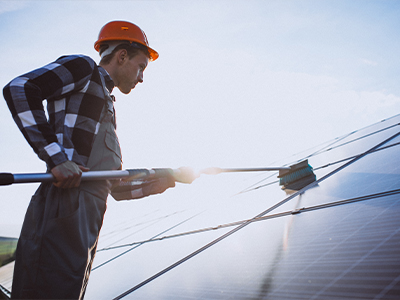Solar Operation & Maintenance Service
Operation & Maintenance (O&M) is one of the most critical ways to ensure that the solar power system gives the best possible generation. At Electrobeam Solar we work to maintain the plant infrastructure and equipment, with the goal of improving the equipment’s life by preventing excess depreciation and impairment. This enables the solar power plant to produce the maximum amount of energy throughout its operational life, perfectly aligning the interests of developers, clients and the investors.
Combining our experience in plant maintenance and advanced diagnostics with our expert O&M staff using a remote monitoring system, Electrobeam Solar ensures the plant functions smoothly, thereby continuously generating solar power.
General Checks
- As a solar plant is installed, engineers at Electrobeam Solar prepare a schedule for preventive maintenance. This includes, but is not limited to, adjustments, cleaning, lubrication, repairs, replacements, and the extension of equipment life. At least twice a year, O&M personnel conduct a general inspection of the installation-site.
- During this inspection, technicians from Electrobeam Solar Ensure roof drainage is adequate, roof drains are not clogged and confirm that there are no signs of water pooling near the array
- Ensure roof penetrations (if any) are watertight
- Check for ground erosion near the footings of a ground mount system
- Confirm electrical enclosures are only accessible to authorised personnel
- Check for corrosion on the outside of enclosures and the racking system
- Check for cleanliness throughout the site to ensure that there is no debris in the inverter pad area or elsewhere
- Check for loose hanging wires in the array
- Check for signs of animal infestation under the array
Specific Checks
Apart from the basic checks, some specific checks happen as part of the preventive maintenance at Electrobeam Solar.
Modules:Modules need the maximum amount of preventive maintenance, and cleaning activities are majorly concentrated around them.
- Frequency of cleaning:In normal conditions, where there isn’t too much dust or dirt, cleaning is carried out on a fortnightly basis. However, in dusty areas such as Rajasthan, the cleaning frequency is increased to once a week.
- Water Quality:The cleaning of the modules is done keeping in mind the TDS (total dissolved solids) levels, water specifications and certain wiping details. In India, the TDS level of the water needs to be at least below 250 parts per million (ppm). The chlorine (less than 250 ppm) and calcium (less than 250 ppm) level of the water, as well as the electrical conductivity, is kept in mind while carrying out the cleaning. Water quality is tested after every six months to ensure that set standards are maintained.
- Quality of cleaning equipment:Brushes without hard bristles (say fibre brushes) should be used for cleaning. A low-quality brush, like one with metal bristles, could negatively impact the glass surface of the modules. In some cases, where hard substances like bird droppings have gotten stuck on the module, engineers use detergent to clean the surface. However, the detergent is not highly concentrated and has very high-water content.
- Post wash care:Post extensive cleaning, modules are wiped off properly to ensure no stain is left to avoid affecting the generation capacity. Since Electrobeam Solar takes up the responsibility of maintaining the plant, our engineers make arrangements for Ultra Poly Vinyl Chloride (UPVC) conduit pipes to ensure water supply. After the system returns to steady-state temperature (i.e. there is no remaining impact from the cooling effect of wash water), the current produced is noted along with weather conditions including temperature, irradiance etc. This maintenance work is recorded in the log book, and the production of the clean system to the previous production values is compared.
Inverter: Most German-make inverter manufacturers recommend servicing it on a quarterly basis. However, Electrobeam Solar carries out servicing on a monthly basis as there is a lot more dust in India compared to other countries. The ventilation is provided via a filter, and this filter needs to be frequently cleaned. Therefore, usage of high-quality filters is advantageous. As part of preventive activities, our engineers check the voltage of the string inverter and record it in the periodic log book. This gives an understanding of voltage fluctuations if any.
MC4 Cabling Connector: Under preventive measures, we ensure that there is no gap between the male and female connector pipes. Any gap, irrespective of the size, could cause a fire and damage the modules. Separately, off-takers can install a “check” meter of equal or higher accuracy with reference to the main meter to cross-check the production level on a monthly basis. All readings have to be, more or less equal, with a 2-3% correction allowance.
Transformer:For transformers at the site with installed capacity in megawatts, parameters such as the operating temperature, OTI (oil temperature), WTI (winding temperature), and oil level are monitored daily. If there is any internal disturbance in the transformer, it reflects in these parameters which are monitored at least three times in a day (at 11 AM, 02 PM and 04 PM as solar power is generated at its peak during these slots). The transformer has to be cleaned thoroughly once in six months. Electrobeam Solar conducts IR test and cable yearly to check the transformer performance.
Protection from external elements: To ensure that the plant is working smoothly (i.e. without any shutdown), the same has to be sealed properly. Else, rats and other rodents can enter, and get electrocuted. This, in turn, can cause a short circuit, and affect the entire plant. Many people are not aware that even high-pressure water can damage the modules. If the water stream is too strong, our team will place the outlet at a farther distance.
Remote monitoring: A solar power plant constantly needs to be monitored to detect breakdowns and optimise its operation. The same function could be performed either on-site or remotely wherein we retrieve all the data either from the inverter or from communicating equipment (probes, meters etc.).


